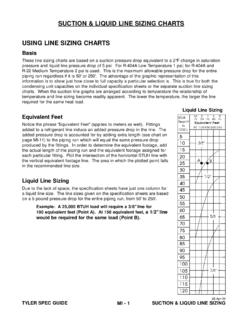Transcription of Understanding Exclusion of the CISG: A New Paradigm of ...
1 Understanding Exclusion of the cisg : A New Paradigm of determining party intent WILLIAM P. JOHNSON . INTRODUCTION. The village market of old has become a global market today. The products we use or consume on a daily basis are produced all over the world. Asparagus grown in Peru, coffee beans harvested in Guatemala, shoes made in Italy, and Japanese automobiles are all readily available to consumers throughout the United States. Moreover, companies even small companies have their products manufactured in foreign jurisdictions where labor is cheap and the necessary raw materials are plentiful. And those companies who do manufacture their products in the United States nevertheless often obtain their parts, components, raw materials, and supplies from sources located outside the United States. In 2009 alone, the total value of imports into the United States of all merchandise . from computers, mobile phones, and Malbec wine to capital equipment, heavy machinery, and oil and gas was a staggering $1,559,624,813, , more than one and a half trillion While the enormous volume of imports into the United States suggests that buyers must have a nearly insatiable appetite for foreign produced merchandise, sellers certainly desire to get their piece of the foreign pie as Assistant Professor of Law, University of North Dakota School of Law.
2 , University of Minnesota , University of Michigan Law School. The author is grateful to Jan Stone for her invaluable assistance, and to Joshua P. Fershee and Michael B. Lopez for taking time to review and provide helpful comments regarding earlier drafts of this article. The author is especially indebted to Chad M. Oldfather for his very helpful remarks and advice. 1. See 2009 Imports from World of NAICS Total All Merchandise, INTERNATIONAL TRADE ADMINISTRATION, (Click on National Trade Data then click Global Patterns of Merchandise Trade under Product click Imports then click Go in the blue bar click View Data Text Only ) (last visited Oct. 29, 2010). That staggering amount was actually down from the preceding four years. See id. 213. 214 BUFFALO LAW REVIEW [Vol. 59. well by selling produced merchandise in foreign markets. In fact, the total value of exports out of the United States of all merchandise in 2009 was $1,056,042,963, , more than one trillion As barriers to trade continue to fall or shrink, trillions of dollars' worth of goods will continue to flow across international borders to and from all corners of the planet.]
3 Side by side with this sleek, sophisticated global marketplace are complex bodies of law governing the transactions that allow the goods to flow, and those bodies of law are fraught with peril for the unsuspecting and the uninitiated: peril for lawyers who are not familiar with these laws that seem to emerge from the international ether as disputes erupt from their clients' cross border arrangements peril for their unsuspecting clients who price their goods based on assumptions that are grounded in law and experience but that ring hollow in international transactions and peril for courts charged with the arduous task of rendering decisions in cross border disputes draped with a tangled web of law, regulations, foreign law, foreign regulations, and international law. One increasingly important body of law that governs certain international sale of goods transactions is the United Nations Convention on Contracts for the International Sale of Goods ( cisg ).3 The cisg is an international treaty that has been ratified by the United States and is part of law.
4 It automatically applies to certain sale of goods transactions. But when it applies or more specifically how it can be excluded has befuddled courts for the cisg 's entire history. One source of confusion has been how to understand the effect of a choice of law clause when such a clause is included in the underlying international contract. By way of example, in American Biophysics, a recent decision by a 2. See 2009 Exports from World of NAICS Total All Merchandise, INTERNATIONAL TRADE ADMINISTRATION, (Click on National Trade Data then click Global Patterns of Merchandise Trade under Product click Exports then click Go in the blue bar click View Data Text Only ) (last visited Oct. 29, 2010). 3. United Nations Convention on Contracts for the International Sale of Goods, opened for signature Apr. 11, 1980, S. Treaty Doc. No. 98 9 (1983), 1489. 3 (entered into force Jan. 1, 1988) [hereinafter cisg ]. 2011] Understanding cisg Exclusion 215. federal court, the underlying written contract that led to the dispute included a choice of law clause providing that the parties' agreement was to be construed and enforced in accordance with the laws of the state of Rhode Island.
5 4 The contract was silent on the cisg . The court concluded that the choice of law clause was sufficient to exclude application of the That conclusion was incorrect. It simply is not the case that a choice of law clause by itself has the effect of excluding application of the cisg . Nevertheless, there is a widespread and growing body of jurisprudence propagating imprecise and incorrect analysis of the cisg and its effective Exclusion . Recently, a federal court in California carelessly stated that [t]he cisg . governs contracts for the sale of goods between parties whose places of business are in different nations, if the nations are Contracting States, unless the subject contract contains a choice of law provision. 6 A clear Understanding of the proper role of a choice of law clause in the analysis of Exclusion of the cisg has therefore been elusive. Moreover, even those courts who have carefully analyzed the role of a choice of law clause have nevertheless often leapt to the erroneous conclusion that Exclusion of the cisg must always be express.
6 Perhaps an even more difficult issue virtually no court has been able to temporarily suspend its traditional notions of contract enforcement and interpretation to engage in the specific kind of analysis that is required by the cisg when determining whether parties to a contract that would be governed by the cisg intended to exclude its application. Specifically, even when there is a written contract with contents that suggest that the parties did not intend to exclude application of the cisg , the cisg . requires courts to consider evidence outside the four corners of the written contract that could show that the parties nevertheless did intend to exclude application of the 4. Am. Biophysics Corp. v. Dubois Marine Specialties, 411 F. Supp. 2d 61, 62 64 ( 2006). 5. Id. at 63. 6. Golden Valley Grape Juice & Wine, LLC v. Centrisys Corp., No. CV F 09 . 1424 LJO GSA, 2010 WL 347897, at *2 ( Cal. Jan. 22, 2010) (emphasis added). 7. See cisg , supra note 3, art. 8. 216 BUFFALO LAW REVIEW [Vol.]
7 59. This is an exercise that is squarely outside the American legal imagination and is likely to be culturally difficult for courts to embrace. In the legal tradition, the statute of frauds requires certain agreements to be evidenced by a writing in order to be enforceable. But under the cisg , there is no requirement for agreements to be concluded in or evidenced by writing. On the contrary, under the cisg , contracts and their terms may be proved by any means, including by Similarly, the parol evidence rule in the legal tradition gives written agreements and their contents a kind of primacy with respect to determining the intent of the parties. If there is a written agreement, then the parol evidence rule makes it difficult or impossible to introduce evidence of the parties' intent from outside the four corners of that agreement. Under the cisg , by contrast, courts are called upon to consider all relevant circumstances of the case including the negotiations, any practices which the parties have established between themselves, usages and any subsequent conduct of the parties to determine the parties' This exercise is anathema in the legal tradition.
8 These concepts, and the underlying emphasis on putting a final agreement into writing and deferring to that written agreement, are simply assumed by many practitioners and courts. The cisg requires a different approach, reflecting a different legal philosophy that tells us, whether correctly or incorrectly, that written agreements should be viewed with some skepticism. And if the parties' actual intent which may be contrary to the objective manifestation of intent evidenced by the writing . can be determined, then the actual intent prevails over a contrary objective intent under the But courts have not recognized their obligation to engage in this kind of analysis when determining whether or not the parties to a written agreement that would be governed by the cisg intended to exclude the cisg . That failure can lead to misapplication of the supreme law of the 8. Id. art. 11. 9. Id. art. 8(3). 10. Id. art. 8. 2011] Understanding cisg Exclusion 217. land, thereby eroding the rule of law established by the Constitution.
9 A haphazard approach to the analysis of application and Exclusion of the cisg also seriously undermines the ability of businesspersons to engage in international business transactions by making impossible their already difficult task of identifying performance obligations implied by law, remedies made available at law, and allocations of risk and responsibility established as defaults under the law. Misunderstanding and inconsistent application of potentially applicable law make it impossible to determine ex ante which body of law the court will choose to provide the answers to the relevant questions. This Article seeks to bring Understanding where there is misunderstanding regarding effective Exclusion of the cisg , including with respect to (i) the role that a choice of . law clause ought to play in the analsyis and (ii) the obligation under the cisg to consider extrinsic evidence to determine the parties' actual intent . To achieve that goal, this Article primarily analyzes four related but distinct items: (1) the text of the cisg itself, (2) the travaux pr paratoires, or drafting history, of the cisg , (3) the American Biophysics decision and the five cases cited as authority by the American Biophysics court to support its incorrect conclusion, and (4) illustrative reasoning of courts that have engaged in analysis, some sound and some faulty, of a variety of other issues under the cisg .
10 I. BACKGROUND ON THE cisg . A. Adoption and Ratification The cisg is an international treaty aimed at providing uniform rules to govern contracts for the international sale of goods in order to, among other things, remove legal barriers in and promote development of international trade, an important element in the promotion of friendly relations among A draft of the cisg was prepared by the United Nations Commission on International Trade Law ( UNCITRAL ), and a diplomatic conference of plenipotentiaries consisting of representatives of sixty two independent states, including the United States, was 11. Id. pmbl. 218 BUFFALO LAW REVIEW [Vol. 59. convened in 1980 to consider the The cisg was adopted at the conference on April 10, 1980, and it was opened for signature on April 11, The cisg was signed on behalf of the United States in 1981, and the Senate ratified the cisg in The cisg entered into force on January 1, 1988, in accordance with Article 99, Section 1 of the cisg after ten countries, including the United States, had deposited with the United Nations their respective instruments of ratification of the B.]






